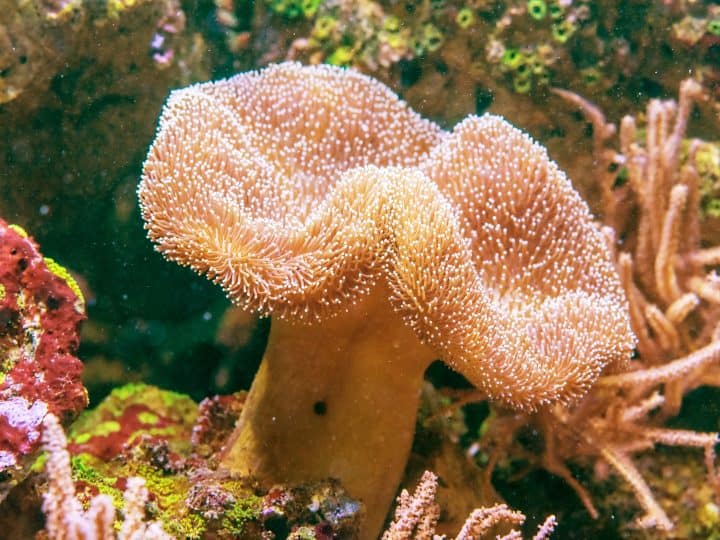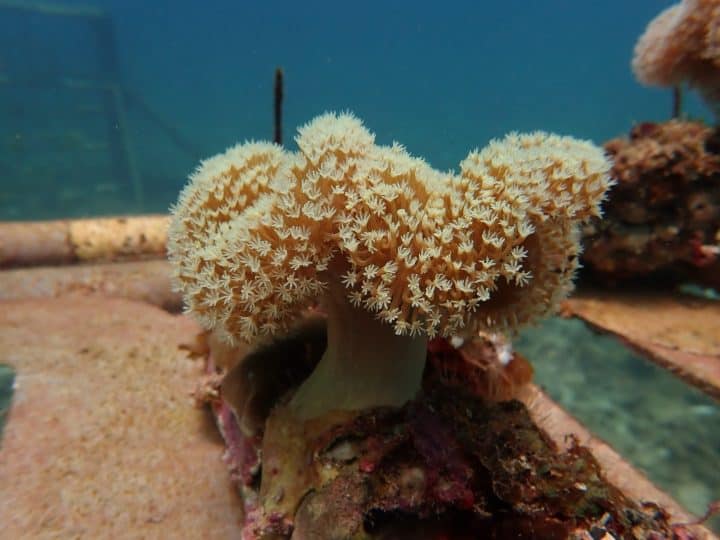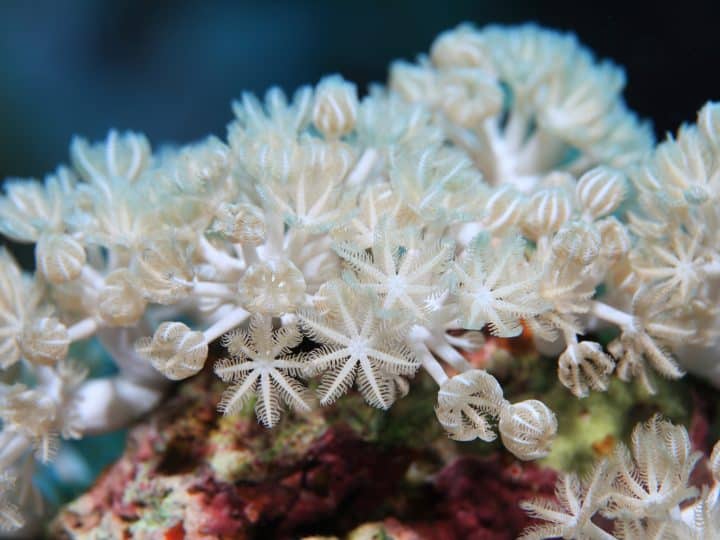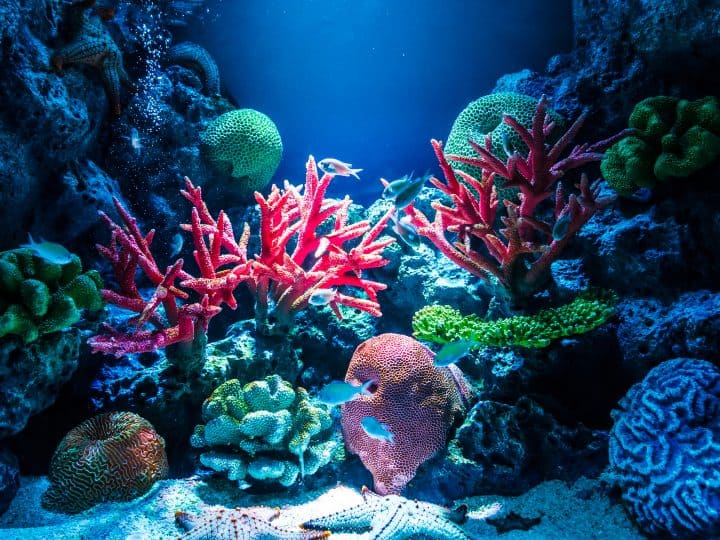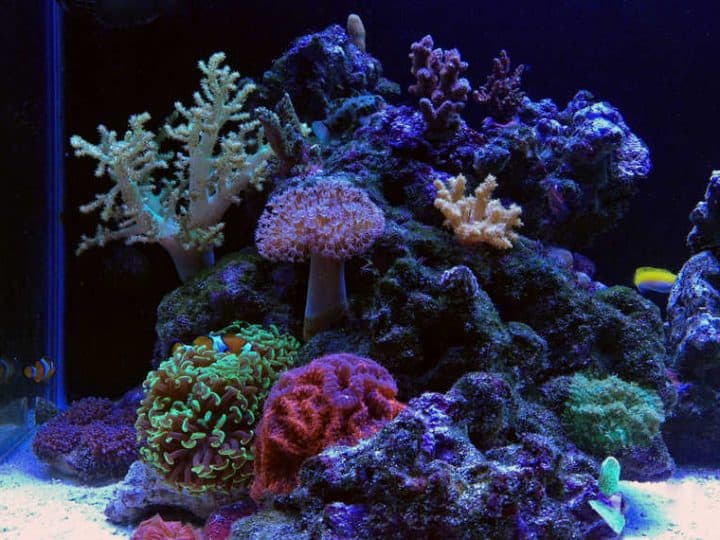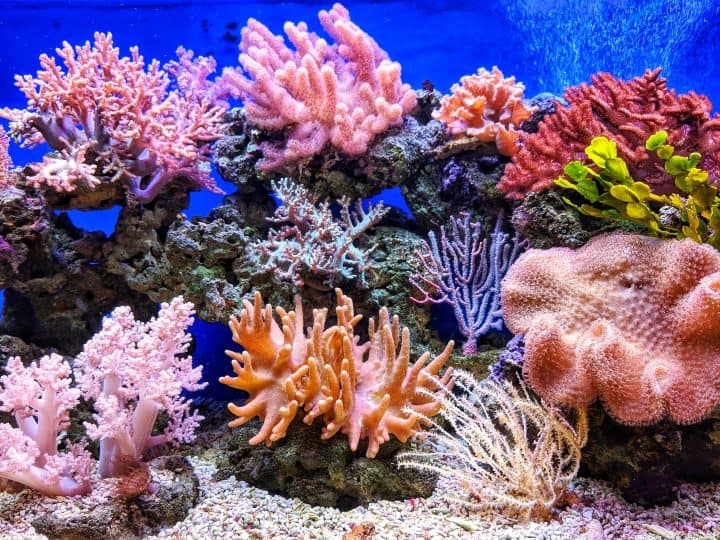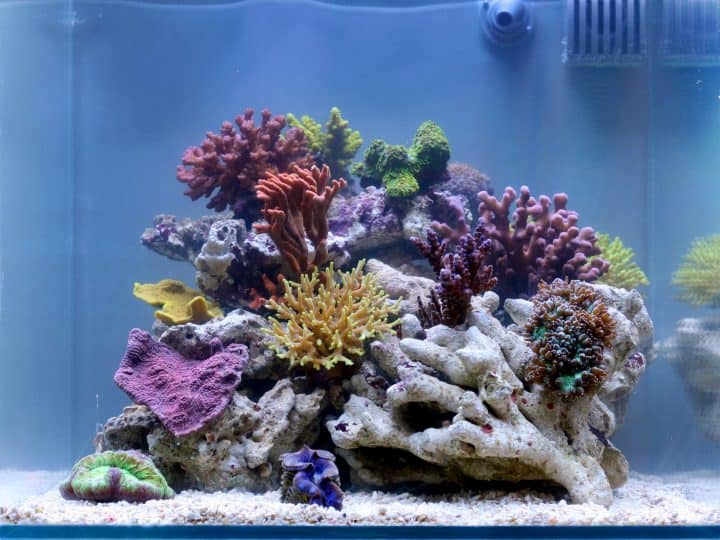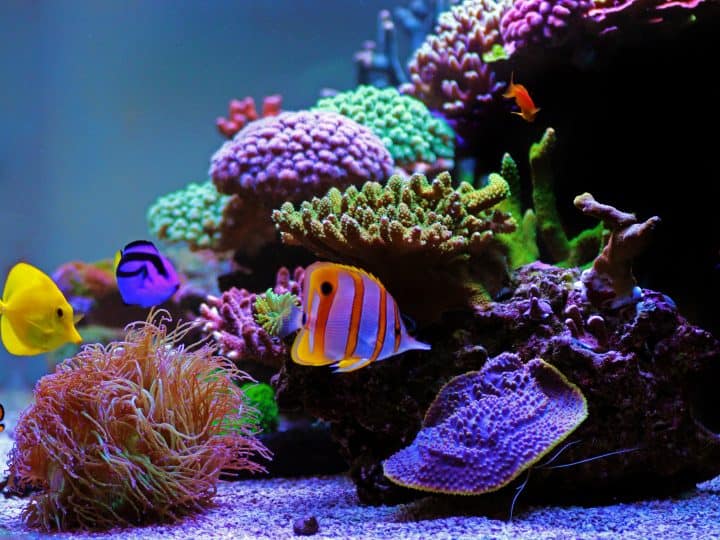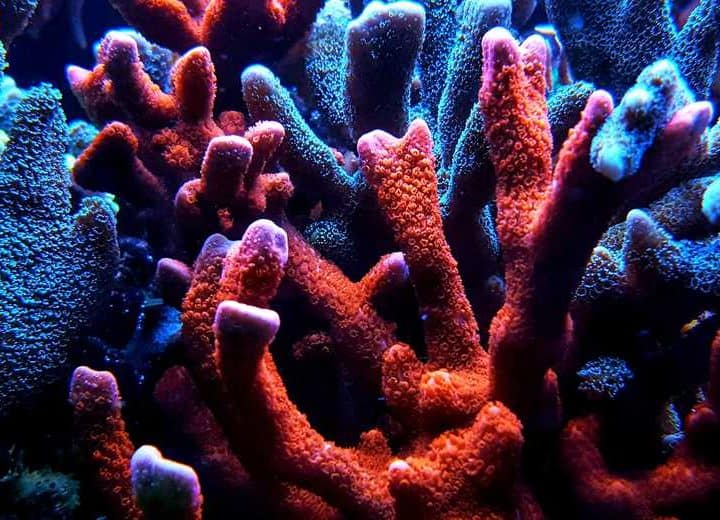As with most of the creatures in your reef tank, corals need light. Their growth depends on the intensity and the spectrum (color) of the light. Do corals need white light to grow in your reef tank?
Quick Answer
Corals don’t need a white light to grow in your reef tank. Instead, they need blue light to grow healthily. White light is more useful to humans, as it helps them ‘see’ the corals in the reef tank better.
Below, I’ll discuss blue, white, and other lighting colors for reef tanks. I’ll also lay down some tips on how to make the most out of your lights. Without further ado, let’s dive into it!
Corals Need Light To Grow?
Corals in reef tanks are photosynthetic, meaning they rely on light, such as blue light, to produce the food they need.
Zooxanthellae, the algae-like beings that live on coral polyps, contain chlorophyll. As such, they need to utilize light to create sugar, the coral’s main source of energy. In fact, zooxanthellae help provide 80–85% of the nourishment that the coral needs.
As an appreciation for the algae’s nutritional gifts, the coral provides them with the shelter and carbon dioxide they need.
This “I scratch your back, you scratch mine” is what scientists call a symbiotic relationship.
What Kind of Light Do Corals Need?
Quick Answer
The blue light spectrum, not white, is what corals need for optimum growth. It helps stimulate coral reef calcification, which is the primary measure of growth. In this process, the corals lay down the foundations of their calcium-rich skeletons.
According to a study, blue spectrum light also helps increase the number of Zooxanthellae in corals. It helps boost Chlorophyll A levels in these algae as well, so if you haven’t already, you may want to make an upgrade in lighting.
For one, Chlorophyll A can only absorb wavelengths ranging from 440 nm to 675 nm. Blue light, with its shorter waves, only has a wavelength of 450 to 495 nm. Indeed, it’s a perfect fit for the photosynthetic needs of Chlorophyll A.
Blue light does more than promote coral growth, though. It can also help influence the coral’s pigmentation, as it boosts the production of chromoproteins.
These give the corals their trademark hues. That’s why when you use blue light in your tank, you’ll see fluorescent colors you won’t see in the traditional full-spectrum lighting.
You Should Balance Your Blue and White Lights
Although corals need blue light more than white, such as oranges and even violet, there’s no need to scrap the latter. As mentioned, they help humans see their corals (and the rest of the reef tank better).
The reason for this is the fact that white light bears green and yellow components. These are the spectrums that humans see best, many thanks to evolution. Humans were wired to see green and yellow better because it’s useful for their early survival in Africa.
That said, there’s no stopping you from choosing your color preferences. After all, many aquarists follow the traditional white/blue balance of 50/50.
When doing so, keep your white light’s intensity below 50% at only half the time. Newer lights are incredibly bright, so they have the potential to shock the coral and stunt its growth.
Red Light Is Also Good
Blue is good for the coral, while white is perfect for the tank owner. Although this is the case, there are other colors you can use in your tank.
Red light is deemed beneficial, as this is the spectrum that algae love. It would help if you didn’t overdo this, though, as this may lead to a harmful algae bloom.
You also need to consider the coral before installing new lights. Deep-water species, such as Stylocoeniella and Leptoseris, aren’t that fond of red light.
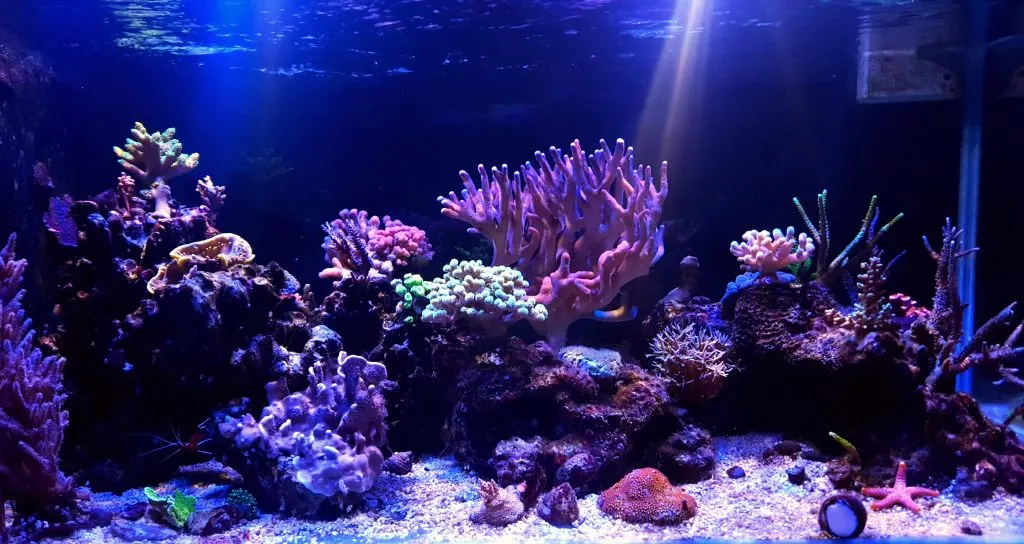
If you’re looking for more information on growing coral, check out my full guide that’ll tell you everything to get you started!
How Many Hours of Light Do Corals Need?
Quick Answer
Corals that use high-intensity illumination need at least 9 hours. Standard-intensity lights, on the other hand, should run for at least 12 hours. Although this is the case, you may need to adjust the duration according to your corals’ light requirements.
High-Intensity Lights Help Corals Create Energy
High-intensity lights have photosynthetically active radiation (PAR) ranging from 250 to 350. PAR refers to the amount of light that enters the water column. This is the light corals can freely use to create energy.
Examples of high-intensity lights include:
- LED fixtures. This can be controlled with an app, which makes it perfect for ramping the lights (and avoiding coral stress).
- Metal halide. This powerful light can provide lighting that promotes better coral growth.
- T5 fixtures featuring six or more bulbs. Cheaper than LED or metal halide, this light allows faster coral growth due to its color blending properties.
A small-polyp scleractinian/stony (SPS) coral is known to require this type of lighting, as it thrives in a PAR of 200 to 400.
Note that standard-intensity lights can function as high-intensity ones in shallow aquariums (breeder or low boy tanks).
Standard Intensity Lights Are Good for Most Corals
Also known as low PAR light, this type of illumination bears a PAR of 250 and below. Examples of low PAR lights include <5 bulbs or lower-quality LED fixtures.
Most corals require standard intensity lights for photosynthesis. These include large-polyp scleractinian/stony (LPS) corals that need about 50-200 PAR.
On the other hand, soft corals will grow with a relatively low PAR of only 25–125.
The Temperature Determines the Color of Light
The color of light is measured through Kelvins (K), roughly -273.15°C or -459.67°F.
Let’s use stars as an example. The sun, which burns at 6,000 K, produces yellow light. An 8,000 to 10,000 K range produces white light, while blue light is generated at 15,000 to 25,000 K.
That said, higher Kelvin bulbs – following the recommended PAR – are best for giving your corals the blue light they need.
Adjust Your Light Duration As Needed
Depending on the coral, you may need to adjust the duration as necessary. For example, the SPS coral Acropora will require more light than other varieties.
That said, it’s not good to turn the lights all the way up as they shock the corals! To prevent this from happening, ramp the lights for about 1.5 hours before the main ‘on-time.’
Add to that, you need to provide your corals with a dark period of about 12 hours. Like humans, corals need to rest, too.
This dark period will allow them to ‘sleep’ and expel the carbon dioxide accumulated during the photosynthetic process. That said, remember that corals need plenty of UV light too so they can perform efficienty photosynthesis, but not too much, or else you may cause excessive algae growth.
How To Acclimate Corals to Light
When corals are nearer to the surface, they get to absorb more lighting. While this may sound good, it’s not. Too much light will prod the algae to produce too much oxygen and sugar for the coral.
As a result, the coral will try to get rid of its algae. Scientists call this coral shock, a process where the coral bleaches and loses its vibrant color.
This is why it’s important to acclimatize your corals to your lighting system. Here are 2 ways on how you can do so:
Introduce New Light to Your Tank Gradually
If you plan on changing the lights in your tank, you’ll need to acclimatize your corals. As I’ve mentioned, new lights have a higher intensity than the old ones. Since your corals have grown used to your old lights, placing them under new ones will shock them.
To prevent this from happening, you need to:
- Raise the new light significantly. This will help reduce intensity by spreading the light throughout the reef.
- Install a window screen or egg crate. Any of these will help minimize the light that reaches the tank.
- Dim your light. While it may be counterintuitive to the previous recommendation, this tip is best for new LED lights. Doing so should help limit the light that reaches the coral. Higher light intensities can cause new corals to suffer from stunted growth, a common reaction.
For best results, run the new light for at least two weeks. As long as the corals don’t bleach, you may increase the intensity by 5% every two weeks.
Place New Corals Near the Tank’s Bottom First
While you may want to place your coral near the surface, you need to acclimatize them first.
Experts recommend placing the new corals near the bottom first. You can put them directly on the sand bar or a frag rack a few inches away from the base.
Bring the coral up a few inches every week, right until you get it where you want to place it permanently. Once there, you may glue your coral with a mix of epoxy putty and super glue.
What You Should Give to Your Corals
Although light is a primary requirement for coral growth, other factors will help your corals calcify. So more than just using the right light spectrum, you need to provide your corals with the following as well:
Give Corals Adequate Water Flow
Corals require water flow to ‘breathe’ and remove their wastes. It needs to be random and indirect, with the flow strength varying according to coral requirements.
SPS corals, for one, require a high water flow. Soft corals — those without a hard shell — need a lower water flow.
Say you have a 250-liter (66.04 gal) aquarium. SPS needs to have a turnover of 50 times an hour, while LPS only requires a 20-per-hour turnover. This equates to 12,500 liters (3,302.15 gal) per hour (lph) for SPS and 5,000 lph for LPS.
Ensure Your Corals Have All Necessary Nutrients
If you want your corals to grow and color well, then you need to provide them with critical nutrients: nitrate and phosphate. Having beginner-friendly corals helps too!
The acceptable nitrate level in saltwater reef tanks is 0.25 parts per million (ppm), not exceeding five ppm.
As for phosphate, the recommended concentration is less than 0.02 ppm.
Make sure to test the water for these nutrients as a nutritional imbalance can be truly disastrous.
For one, the lack of nutrients will kill the algae, thus leading to a loss of color. This bleaching occurs because the Zooxanthellae is expelled from the coral.
On the other hand, an excess of nutrients will drive the algae to bloom, causing the coral to turn an unsightly brown. That’s because, in large numbers, Zooxanthellae look like a big clump of brown/golden-yellow filaments.
Provide Elements Essential to the Corals’ Growth
Corals in the ocean grow beautifully because of the interplay of elements and water alkalinity. In fact, they help the corals process the lighting that it needs as well.
That said, it’s essential to mimic these variables to ensure coral growth:
- Salt. The recommended specific gravity is 1.024 to 1.026, which corresponds to 32 to 35 parts per thousand. This range will help improve the rate of coral calcification.
- Alkalinity. Keeping your reef tank pH stable (7 to 10 dKh) will help promote coral growth. The water, if left unbalanced, can cause alkaline burn and coral tissue loss. Products that best help maintain reef alkalinity include sodium bicarbonate or soda ash.
- Calcium. Corals need calcium for their skeleton; therefore, you need to maintain an optimal calcium range of 400 to 450 ppm. If not, this vital mineral may end up depleted right away.
- Magnesium. This element helps prevent the calcium in the tank from precipitating. The ideal range for reef tanks is 1250 to 1500 ppm.
- Strontium. This mineral can help with the coral’s calcium absorption. As such, a concentration of 8 million ppm will help promote faster skeleton building.
- Iodine. At a range of 0.06 ppm, iodine can help the corals adapt to different lighting conditions. Low levels, on the other hand, can stunt coral growth and lead to dull-colored tissue.
- Iron. If you have SPS corals, iron (at 0.1 to 0.5 mg/liter) will help them achieve a beautiful green color.
- Potassium. At 380 to 420 mg/liter, Potassium helps boost the skeleton formation of several stony corals. An imbalance in Potassium can adversely affect the growth and the color of the corals.
Final Thoughts
The right kind of light — blue — is needed for the coral growth process. It helps the corals grow their skeletons and produce their vibrant pigments.
White light, on the other hand, benefits the aquarist more than the corals. Humans see in white light better, which is why most hobbyists use a balanced (50/50) lighting of white and blue.
Light isn’t the only thing that you should pay attention to, though. For the best results, you need to provide your corals with the nutrients, elements, and water flow they need. Don’t forget that a bit of coral-specific fertilizer goes a long way too!
However, providing live corals with light of optimal wavelengths according to the correct spectrum of light, combined with adequate light intensity, is crucial for strong coral growth.

